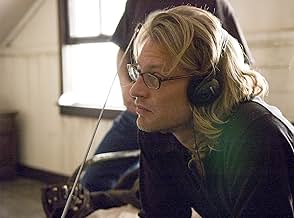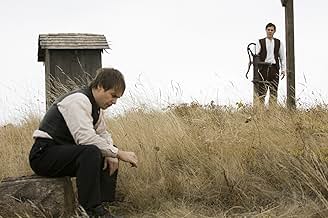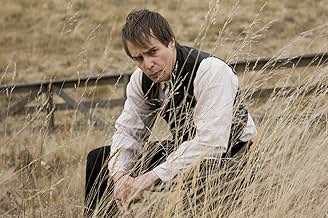Robert Ford, who has idolized Jesse James since childhood, tries hard to join the resurgent gang of the Missouri outlaw, but gradually becomes resentful of the bandit leader.Robert Ford, who has idolized Jesse James since childhood, tries hard to join the resurgent gang of the Missouri outlaw, but gradually becomes resentful of the bandit leader.Robert Ford, who has idolized Jesse James since childhood, tries hard to join the resurgent gang of the Missouri outlaw, but gradually becomes resentful of the bandit leader.
- Nominated for 2 Oscars
- 25 wins & 69 nominations total
- Baggagemaster
- (as James DeFelice)
- Danish Train Passenger
- (as Torben S. Hansen)
- Director
- Writers
- All cast & crew
- Production, box office & more at IMDbPro
Storyline
Did you know
- TriviaCinematographer Roger Deakins has called the arrival of the train in darkness as one of the high points of his career.
- GoofsJesse James uses the term "gunslinger" but this term didn't come into use until at least the 1920's. Terms for outlaw gunmen appropriate for the time would have been gunman, pistoleer, shootist, or even gunfighter.
- Quotes
[last lines]
Narrator: He was ashamed of his persiflage, his boasting, his pretensions of courage and ruthlessness; he was sorry about his cold-bloodedness, his dispassion, his inability to express what he now believed was the case- that he truly regretted killing Jesse, that he missed the man as much as anybody and wished his murder hadn't been necessary. Even as he circulated his saloon he knew that the smiles disappeared when he passed by. He received so many menacing letters that he could read them without any reaction except curiosity. He kept to his apartment all day, flipping over playing cards, looking at his destiny in every King and Jack. Edward O'Kelly came up from Bachelor at one P.M. on the 8th. He had no grand scheme. No strategy. No agreement with higher authorities. Nothing but a vague longing for glory, and a generalized wish for revenge against Robert Ford. Edward O'Kelly would be ordered to serve a life sentence in the Colorado Penitentiary for second degree murder. Over seven thousand signatures would eventually be gathered in a petition asking for O'Kelly's release, and in 1902, Governor James B. Ullman would pardon the man. There would be no eulogies for Bob, no photographs of his body would be sold in sundries stores, no people would crowd the streets in the rain to see his funeral cortege, no biographies would be written about him, no children named after him, no one would ever pay twenty-five cents to stand in the rooms he grew up in. The shotgun would ignite, and Ella Mae would scream, but Robert Ford would only lay on the floor and look at the ceiling, the light going out of his eyes before he could find the right words.
- Crazy creditsThe film does not contain either an opening title nor intro credits. The film title is displayed first after the final fadeout.
Visually, the film soars beyond anything that has hit the screen since Conrad Hall's final masterpiece with Road to Perdition. Roger Deakins, the cinematography genius behind The Shawshank Redemption, Kundun, and all the Cohen brothers" films since The Hudsucker Proxy, surpasses his best work. He pulls out all the stops hereintricately orchestrated changes in focus, richly textured colors, dazzling use of light sources, careful manipulations of time, powerfully significant fade-ins and fade-outs, and shots through rain, snow, and rippled old glassto communicate the story. Deakins' contribution stands out in the railroad train robbery sequence at the beginning of the film. Clearly defined, flickering light sources and deep black shadows create a dazzling, nightmarish vision that haunts the rest of the film. This sequence alone is worth the price of admission.
The richly textured, historically precise visual aspects of the film bring to mind Terrence Malick's Days of Heaven and Robert Altman's McCabe and Mrs. Miller. However, instead of the understated, "realistic" performances featured in those films, The Assassination of Jesse James showcases powerful, yet still realistic performances by an outstanding ensemble cast.
Sam Rockwell, as the not-too-bright but well-meaning Charley Ford, and Mary-Louise Parker, as Jesse's loving wife, stand out. Yet the film belongs to the two titular leads, both of whom deliver the performances of their careers and create characters filled with disturbing contradictions. Brad Pitt's Jesse James is alternately pitiable and terrifyingan affectionate, loving father, an old-before-his-time sage, an adventurous daredevil, an unrepentant bad boy, and a vicious sociopath. Casey Affleck's Robin Ford is a complex, repellent, and tragic character who challenges the audience's complicity in the undercurrents of the film.
All in all, this is a great filmnot for those seeking the simple pleasures of instant gratification. But definitely worth the attention of those who still believe that movies are an art form.
- rick-j-walsh
- Oct 15, 2007
- Permalink
Details
- Release date
- Countries of origin
- Official sites
- Languages
- Also known as
- El asesinato de Jesse James por el cobarde Robert Ford
- Filming locations
- Production companies
- See more company credits at IMDbPro
Box office
- Budget
- $30,000,000 (estimated)
- Gross US & Canada
- $3,909,149
- Opening weekend US & Canada
- $147,812
- Sep 23, 2007
- Gross worldwide
- $15,003,764
- Runtime2 hours 40 minutes
- Color
- Sound mix
- Aspect ratio
- 2.39 : 1
Contribute to this page






































